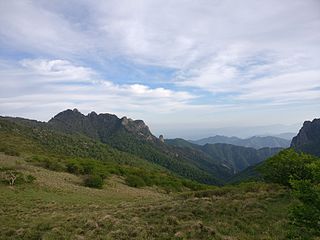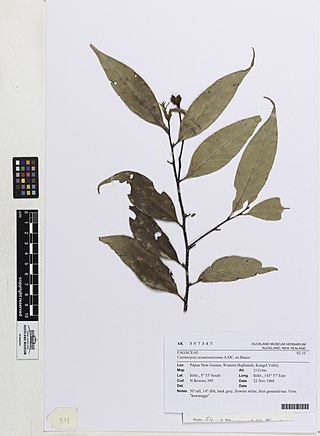
Temperate rainforest are coniferous or broadleaf forests that occur in the temperate zone and receive heavy rain.

The Qinling or Qin Mountains, formerly known as the Nanshan, are a major east–west mountain range in southern Shaanxi Province, China. The mountains mark the divide between the drainage basins of the Yangtze and Yellow River systems, providing a natural boundary between North and South China and support a huge variety of plant and wildlife, some of which is found nowhere else on earth.

Laurel forest, also called laurisilva or laurissilva, is a type of subtropical forest found in areas with high humidity and relatively stable, mild temperatures. The forest is characterized by broadleaf tree species with evergreen, glossy and elongated leaves, known as "laurophyll" or "lauroid". Plants from the laurel family (Lauraceae) may or may not be present, depending on the location.
An evergreen forest is a forest made up of evergreen trees. They occur across a wide range of climatic zones, and include trees such as conifers and holly in cold climates, eucalyptus, Live oak, acacias, magnolia, and banksia in more temperate zones, and rainforest trees in tropical zones.

California mixed evergreen forest is a plant community found in the mountain ranges of California and southwestern Oregon.

The Central Mountain Range is the principal mountain range on the island of Taiwan. It runs from the north of the island to the south. Due to this separation, connecting between the west and east is not very convenient. The tallest peak of the range is Xiuguluan Mountain, 3,860 m (12,664 ft).

The Chin Hills-Arakan Yoma montane forests is a tropical and subtropical moist broadleaf forest ecoregion in western Myanmar (Burma). Surrounded at lower elevations by moist tropical forests, this ecoregion is home a diverse range of subtropical and temperate species, including many species characteristic of the Himalayas, as well as many endemic species.

The Taiwan subtropical evergreen forests is an ecoregion that covers most of the island of Taiwan, with the exception of the southern tip of the island, which constitutes the South Taiwan monsoon rain forests ecoregion. The island's concentrated steep mountains host a range of forest types, from subtropical forests in the lowlands to temperate and alpine or montane forests.

The Northern Indochina subtropical moist forests are a subtropical moist broadleaf forest ecoregion of northern Indochina, covering portions of Vietnam, Laos, Thailand, Myanmar, and China's Yunnan Province.

The Northern Triangle temperate forests is a temperate broadleaf and mixed forest ecoregion of thick forest covering the mountains of northern Myanmar.

Castanopsis acuminatissima is an evergreen tree native to Southeast Asia and New Guinea. It is known by a variety of common names over its range, including white oak, New Guinea oak, Papua New Guinea oak, ki riung, ko-duai, ko-soi, ko-mat, meranak, and riung anak.

The flora of Japan comprises a large assemblage of plant species which can be found in Japan, such as sakura, katsura, momiji and azalea. There are many species which are endemic to Japan.
The ecology of the Himalayas varies with climate, rainfall, altitude, and soils. The climate ranges from tropical at the base of the mountains to permanent ice and snow at the highest elevations. The amount of yearly rainfall increases from west to east along the southern front of the range. This diversity of climate, altitude, rainfall and soil conditions supports a variety of distinct plant and animal species, such as the Nepal gray langur
Castanopsis fargesii Is an evergreen tree that grows 10–30 m tall.

Castanopsis argentea is an evergreen tree native to Indonesia, where it is known as sarangan. It is native to the islands of Java and Sumatra.

The Jiang Nan subtropical evergreen forests ecoregion covers the mountainous divide between the lower Yangtze River and the coastal plain of South China. The region is also a climatic divide between the temperate valleys of the north and the subtropical forests of the south. The region is important for biodiversity and endemic species. The rugged limestone karst hills have been relatively protected from conversion to agriculture, and support specialized plant and animal communities.

The Peninsular Malaysian montane rain forests is an ecoregion on Malay Peninsula. It occupies the mountainous spine of the peninsula in Malaysia and southernmost Thailand. It is in the tropical and subtropical moist broadleaf forests biome.

The Luang Prabang montane rain forests ecoregion covers elevations over 800 meters in the Luang Prabang mountains that straddle the border between northern Thailand and north-central Laos, and the highlands that stretch eastward across north-central Laos. While much of the forest cover has been degraded, there are still large areas of relatively untouched forest.

The Northern Vietnam lowland rain forests ecoregion covers the central-eastern coast of Vietnam from the Red River delta in the north to Tam Kỳ in the center of the country and neighboring adjacent parts of Laos. The region is one of the wet evergreen forests, with rain over 50 mm in every month. The forests have been highly degraded by human use, and the high levels of biodiversity have been pushed back into relatively small protected areas like Pu Mat National Park.

Castanopsis eyrei is a species of flowering plant in the family Fagaceae, native to southern China, and Taiwan. An evergreen tree typically 8 to 20 m tall, it is usually found in late successional forests from 300 to 1,700 m above sea level, where it is often the dominant species. It is used as a street tree in a number of southern Chinese cities.
















